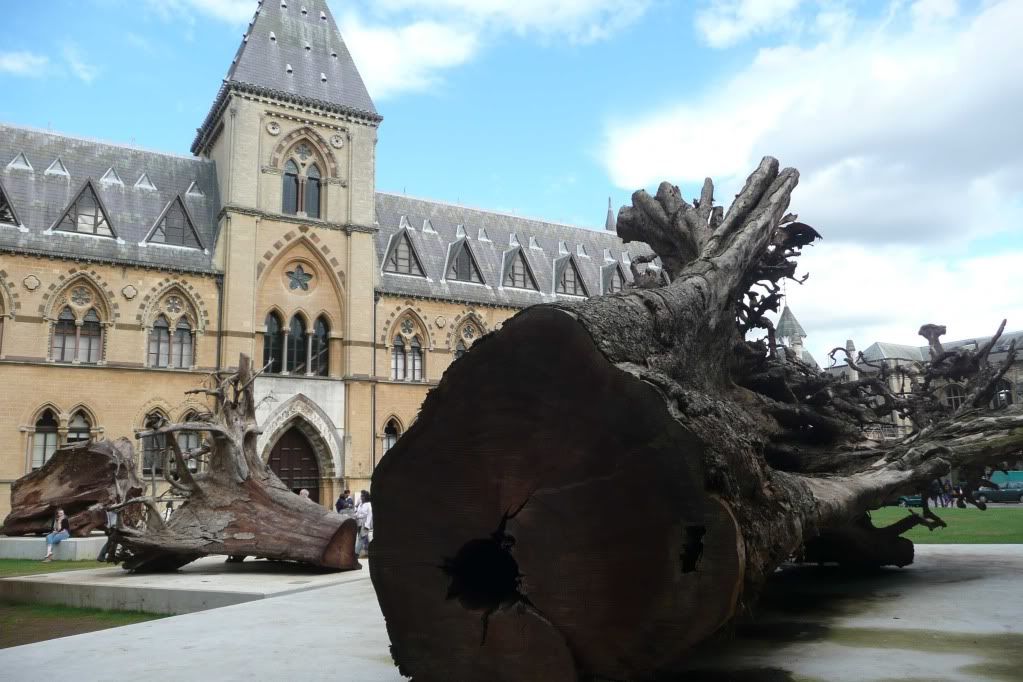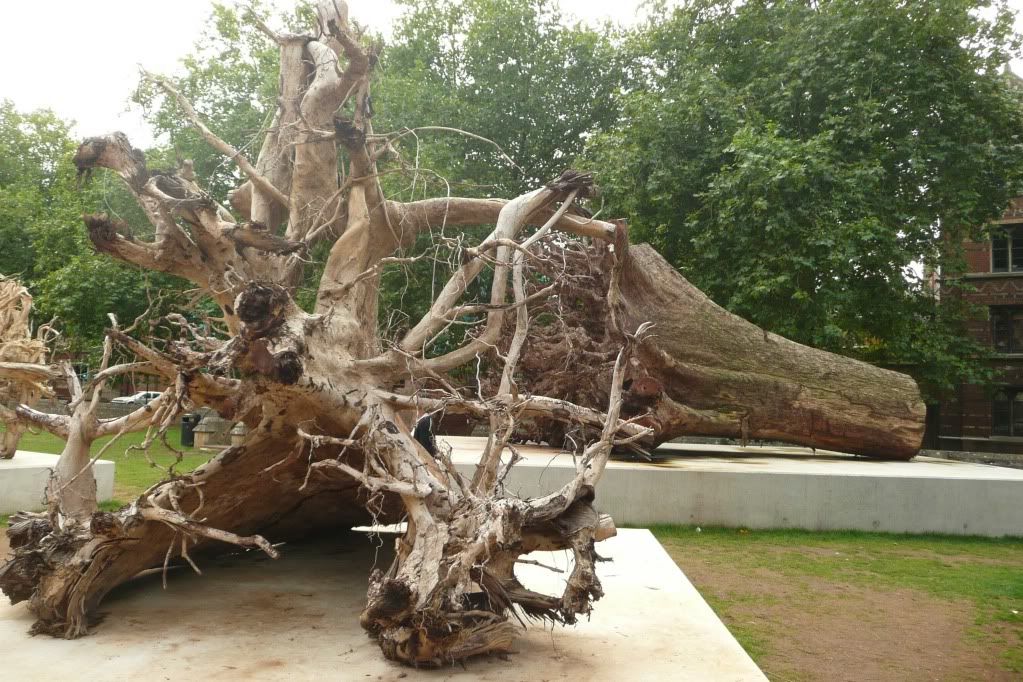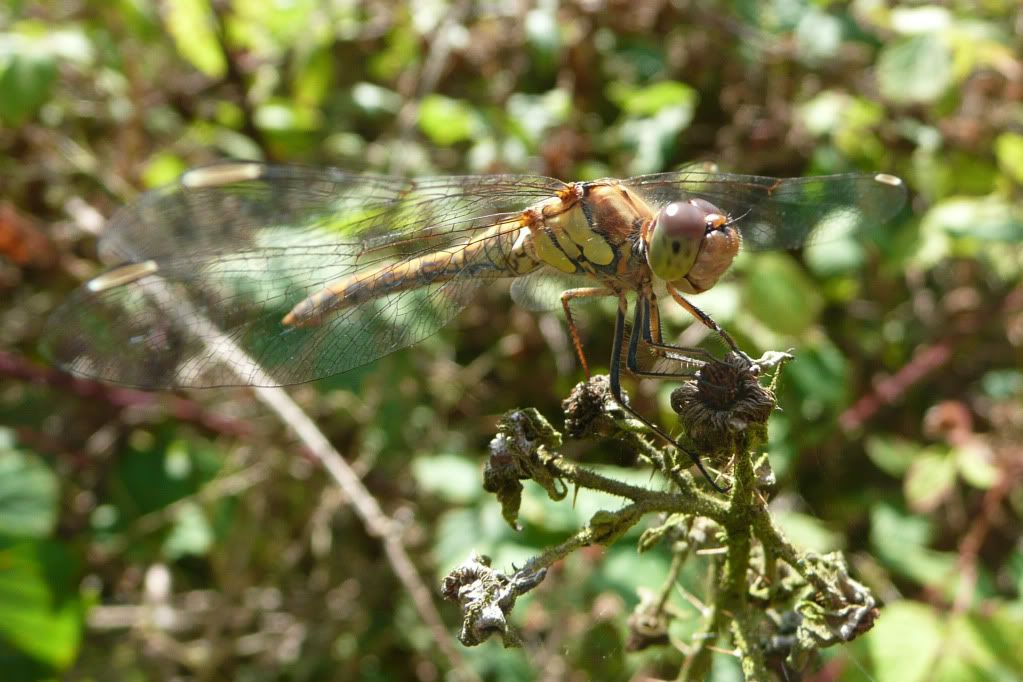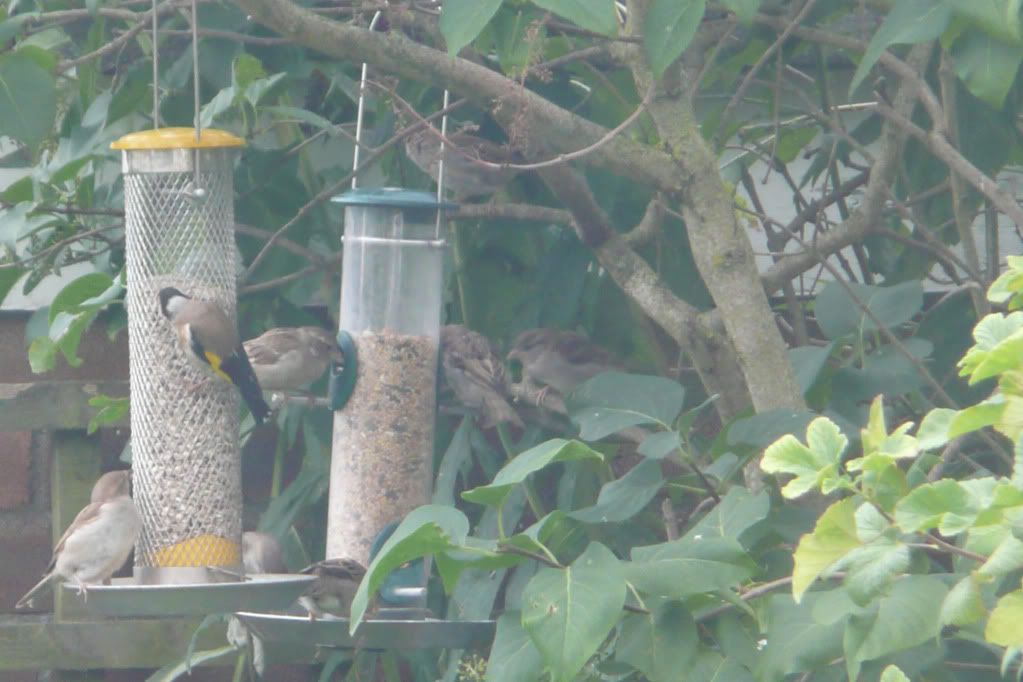It's not often this blog focuses on works of art, but an installation at the University Oxford Natural History Museum has a huge installation of trees felled in the Ghana rainforest.
For some reason, there seem to be less tourists in Oxford at bank holiday weekends, so an ideal chance to have a look at it.
.
The work of artist Angela Palmer, the Ghost Forest installation has previously been exhibited in Trafalgar Square, London and Thorvaldsens Plads, Copenhagen.
The aim of the project is draw attention to the scale of deforestation in the worlds tropical rainforestsr. Currently an area the size of Belgium is cleared each year.
.
An information display tells how these trees were felled from a licenced logging company, which can only fell selected trees in a given area and when complete, the area must be left for several years for sapplings to grow and the forest to regenerate.
.
I'm not an art critic but I would have liked more information on how us as individuals could play our part in supporting such schemes as the one in Ghana
Still, there is no doubt the stumps are very impressive, as this 360 degree panorama fails to show:
.
The installation will be in place until July 2011 an I would recommend it to anyone who is in the area and any opportunity to visit the wonderful University of Oxford Natural History Museum - my favourite place in Oxford, if not the world - should be taken.
More information on the Ghost Forest project (complete with better pictures) can be found at:
http://www.ghostforest.org
Wildlife and other things of interest on and around the river Ock in south Oxfordshire
Saturday, 28 August 2010
Thursday, 26 August 2010
Views of the pavement
Whilst walking back from the river the other day, I noticed a clump of plants growing through the pavement. Every year they seem to get cut and every year they grow back.
.
.
But closer inspection it turns out to be a haven for ladybirds, including the larvae of an invasive harlequin:
.
.
After a few weeks the larvae turn into pupa, also seen on the same plant:
.
.
The full size adult then emerges, on these plants there countless seven spot adults. Perhaps surprisingly, there were no obvious harlequin adults.
.
.
Although the seven spot is one of the UK's most common ladybirds, the rapid spreading of the harlequin may soon out compete it - as harlequins will feed on the eggs, larvae and pupae of the native ladybirds:
But closer inspection it turns out to be a haven for ladybirds, including the larvae of an invasive harlequin:
.
.
After a few weeks the larvae turn into pupa, also seen on the same plant:
.
.
The full size adult then emerges, on these plants there countless seven spot adults. Perhaps surprisingly, there were no obvious harlequin adults.
.
.
Although the seven spot is one of the UK's most common ladybirds, the rapid spreading of the harlequin may soon out compete it - as harlequins will feed on the eggs, larvae and pupae of the native ladybirds:
Monday, 23 August 2010
Weekend wildlife..
A selection of the 174 pictures taken over the weekend...
.
.
Young moorhen
.
.
A remarkably still dragonfly (accounting for a large proportion of the weekend picture tally)
.
.
Recently hatched insect larvae on a window
.
.
Obligatory water vole.
.
.
.
Young moorhen
.
.
A remarkably still dragonfly (accounting for a large proportion of the weekend picture tally)
.
.
Recently hatched insect larvae on a window
.
.
Obligatory water vole.
.
Sunday, 22 August 2010
Feeding Frenzy
There aren't too many wildlife spectacles that can be witnessed in a back garden in Oxfordshire. But today a flock of maybe up to 50 house sparrows descended on us.
Sparrows are not uncommon in our garden, but never in such numbers, perhaps it's the change in weather, the refilled bird feeders or ants in the garden were swarming.
Whatever the reason, watching them flying around the garden and arguing with each other is a great way to spend the late afternoon having spent a weekend unblocking drain pipes:
.
.
.
.
The national population of house sparrows has dropped by 65% since the 1970's which has resulted in it being placed on the 'red list'. So not only an entertaining spectacle, but hopefully signs of a successful breeding season.
Sparrows are not uncommon in our garden, but never in such numbers, perhaps it's the change in weather, the refilled bird feeders or ants in the garden were swarming.
Whatever the reason, watching them flying around the garden and arguing with each other is a great way to spend the late afternoon having spent a weekend unblocking drain pipes:
.
.
.
.
The national population of house sparrows has dropped by 65% since the 1970's which has resulted in it being placed on the 'red list'. So not only an entertaining spectacle, but hopefully signs of a successful breeding season.
Sunday, 15 August 2010
Kingfishers
Since this blog started 18 months ago it has featured numerous creatures - badgers, water voles and discussed the possibility of otters. But there is one common animal that has only been mentioned in passing - kingfishers.
Kingfishers are common along the ock, which is hardly surprising - the steep soft banks are ideal for nesting and the overhanging branches of sycamore and willow trees are ideal for perching on before catching one of the plentiful supply of small fish. In fact no walk along the ock would be complete without at least one sighting of a bright flash and a high pitched whistle as one flies past.
But there is one simple reason for kingfishers not featuring very prominently in this blog - they can be very difficult to photograph.
For a start, they are surprisingly small, an adult is only 15 cm tall and despite their almost exotic colourings, they can be quite hard to spot if they're perched on the branch. And eventually when one is located, they don't often stay still for long, often disturbed by cyclists, dogs or over optimistic photographers.
This juvenile shows how difficult it can be to see them, as it sits on a reed:
.
.
The best place to see kingfishers - if not to photograph them - is along the lower ock as it flows through the ock valley walk:
.
.
.
Maybe with a bit more practice and lot more patience, better photographs may appear before the kingfishers leave the ock for winter.
.
Kingfishers are common along the ock, which is hardly surprising - the steep soft banks are ideal for nesting and the overhanging branches of sycamore and willow trees are ideal for perching on before catching one of the plentiful supply of small fish. In fact no walk along the ock would be complete without at least one sighting of a bright flash and a high pitched whistle as one flies past.
But there is one simple reason for kingfishers not featuring very prominently in this blog - they can be very difficult to photograph.
For a start, they are surprisingly small, an adult is only 15 cm tall and despite their almost exotic colourings, they can be quite hard to spot if they're perched on the branch. And eventually when one is located, they don't often stay still for long, often disturbed by cyclists, dogs or over optimistic photographers.
This juvenile shows how difficult it can be to see them, as it sits on a reed:
.
.
The best place to see kingfishers - if not to photograph them - is along the lower ock as it flows through the ock valley walk:
.
.
.
Maybe with a bit more practice and lot more patience, better photographs may appear before the kingfishers leave the ock for winter.
.
Monday, 9 August 2010
The crayfish murders - another victim...
Last month, I wrote a post on about a mutilated crayfish corpse on the river. Having considered several suspects I concluded the most likely culprit was an otter.
In the comments section David suggest that it may be a badger - something I hadn't considered. Badgers are surprisingly common, with an estimated 250,000 living in the UK and I have seen them near Abingdon last year: http://viewsoftheock.blogspot.com/2009/11/badger.html
Whilst walking to work and pondering the circumstances which a badger and crayfish are likely to meet I came across another dead crayfish:
.
.
This one was found in a different part of the river, the lower ock along the ock valley walk in a place that is popular for people to fish. It also has different wounds, the first one was ripped in half by what seemed like a frenzied attack, whilst this one has a smaller wound in the tail:
.
.
Having examined the area, there are no obvious spraints, but it does make sense for otters to spend most of their time in the nearby Thames and occasionally coming into the shallower Ock to feed.
Although if it had been an otter, it is more likely the entire tail would have been consumed rather than just a small bite, unless it was disturbed.
Later in the day, there was evidence of more crayfish abuse, this time the culprit is obvious:
.
.
Would a moorhen kill a crayfish? I doubt it, I suspect this bird is just being opportunistic.
So if it wasn't the moorhen, then what was it? Although I still think the first crayfish victim was the result of an otter attack, I doubt this one was. But to be honest, I'm not sure what did it, maybe it was just the accidental victim of an errant fishing hook.
Needless to say, I will be keeping an eye open for more evidence and as always, suggestions are welcome.
In the comments section David suggest that it may be a badger - something I hadn't considered. Badgers are surprisingly common, with an estimated 250,000 living in the UK and I have seen them near Abingdon last year: http://viewsoftheock.blogspot.com/2009/11/badger.html
Whilst walking to work and pondering the circumstances which a badger and crayfish are likely to meet I came across another dead crayfish:
.
.
This one was found in a different part of the river, the lower ock along the ock valley walk in a place that is popular for people to fish. It also has different wounds, the first one was ripped in half by what seemed like a frenzied attack, whilst this one has a smaller wound in the tail:
.
.
Having examined the area, there are no obvious spraints, but it does make sense for otters to spend most of their time in the nearby Thames and occasionally coming into the shallower Ock to feed.
Although if it had been an otter, it is more likely the entire tail would have been consumed rather than just a small bite, unless it was disturbed.
Later in the day, there was evidence of more crayfish abuse, this time the culprit is obvious:
.
.
Would a moorhen kill a crayfish? I doubt it, I suspect this bird is just being opportunistic.
So if it wasn't the moorhen, then what was it? Although I still think the first crayfish victim was the result of an otter attack, I doubt this one was. But to be honest, I'm not sure what did it, maybe it was just the accidental victim of an errant fishing hook.
Needless to say, I will be keeping an eye open for more evidence and as always, suggestions are welcome.
Thursday, 5 August 2010
Bees in the Garden
This time of year can be very difficult for an inexperienced amateur to try and identify bumblebees. First generation workers are looking faded, second generation workers are more colourful, next years queens have taken to the wing, emerged males can look totally different to the female of the same species and just to add to the confusion cuckoo bumblebee queens look remarkably (but slightly different) to the hosts whose nests they hope to parasitise next year.
Unlike the nearby meadows, which have mostly turned to seed, the plants in the garden are still in flower and providing an a source of food to the bees and so it is an opportunity to use the 'Field Guide to Bumblebees' (Edwards & Jenner) to try and identify them.
.
A common carder bee on purple toadflax - an annual that seems to attract more bees than any other flower in the garden:
.
.
On the buddleia, what appears to be a queen buff tailed bumblebee; differentiated from a white tailed bumblebee by the thin yellow line above the white tip of the abdomen.
.
.
On the lavender, a male red-tailed bumblebee, it differs from the females by the yellow markings on the thorax and head. Also, males don't collect pollen and don't sting.
.
.
A queen red tailed bumblebee is usually easily identified, but when she is covered in pollen from the latvatera it becomes a bit more difficult.
.
Unlike the nearby meadows, which have mostly turned to seed, the plants in the garden are still in flower and providing an a source of food to the bees and so it is an opportunity to use the 'Field Guide to Bumblebees' (Edwards & Jenner) to try and identify them.
.
A common carder bee on purple toadflax - an annual that seems to attract more bees than any other flower in the garden:
.
.
On the buddleia, what appears to be a queen buff tailed bumblebee; differentiated from a white tailed bumblebee by the thin yellow line above the white tip of the abdomen.
.
.
On the lavender, a male red-tailed bumblebee, it differs from the females by the yellow markings on the thorax and head. Also, males don't collect pollen and don't sting.
.
.
A queen red tailed bumblebee is usually easily identified, but when she is covered in pollen from the latvatera it becomes a bit more difficult.
.
Subscribe to:
Comments (Atom)

























